BTEC Level 5: Theories, Principles and Models in Education & Training
VerifiedAdded on 2022/12/15
|14
|5112
|258
Report
AI Summary
This report provides a comprehensive analysis of theories, principles, and models in education and training. It covers learning theories such as behaviorism, cognitivism, social constructivism, and connectivism, explaining their application in teaching, learning, and assessment. The report also examines learning preference models like VAK and Honey and Mumford's model, highlighting their importance in inclusive teaching. Furthermore, it delves into communication models (assertive, aggressive, passive) and theories (social exchange theory), assessment models, curriculum development theories, and reflection and evaluation models, explaining their application in enhancing educational practices. The document concludes by emphasizing the significance of these theories and models in improving teaching methodologies and student learning experiences, with all resources available for students on Desklib.
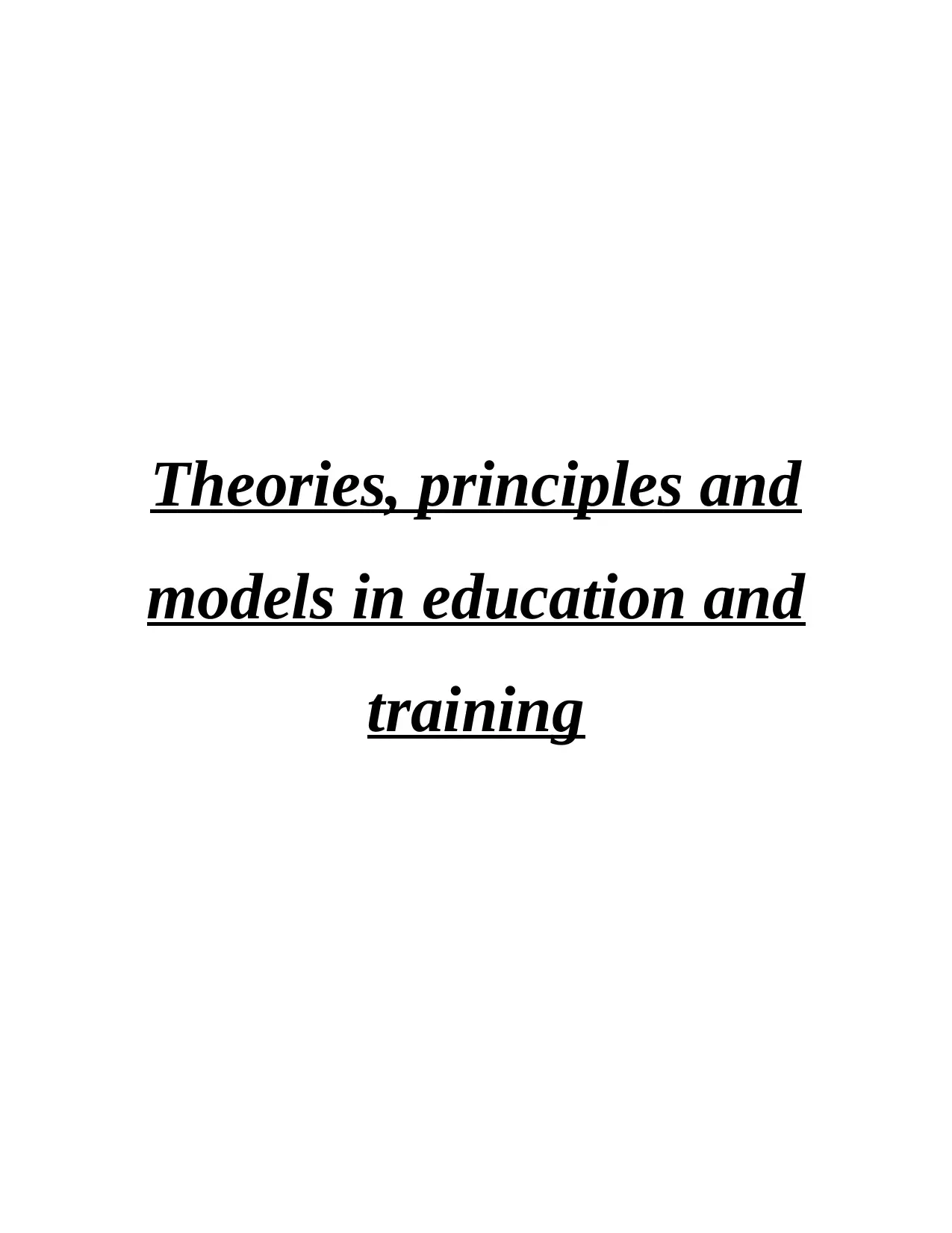
Theories, principles and
models in education and
training
models in education and
training
Paraphrase This Document
Need a fresh take? Get an instant paraphrase of this document with our AI Paraphraser
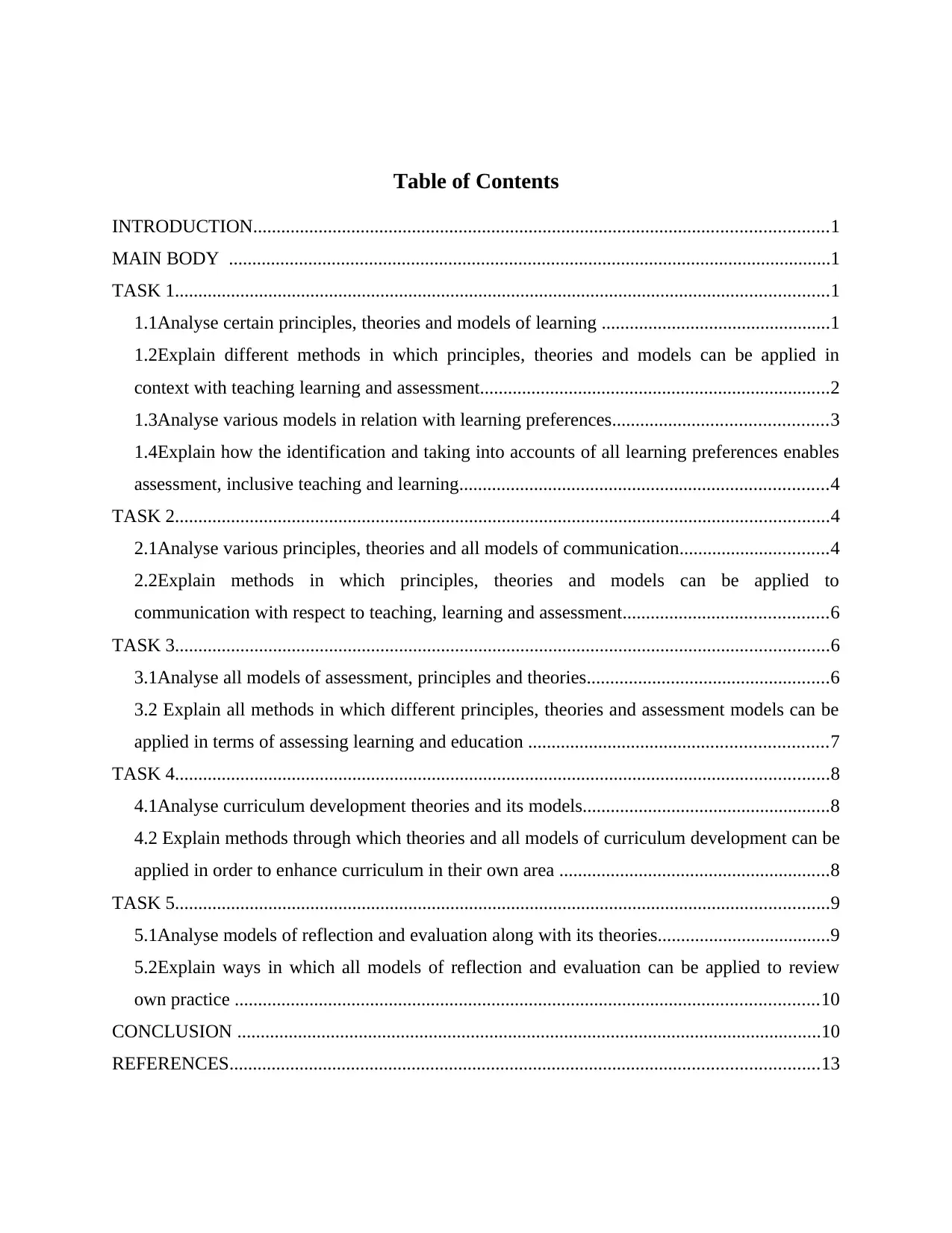
Table of Contents
INTRODUCTION...........................................................................................................................1
MAIN BODY .................................................................................................................................1
TASK 1............................................................................................................................................1
1.1Analyse certain principles, theories and models of learning .................................................1
1.2Explain different methods in which principles, theories and models can be applied in
context with teaching learning and assessment...........................................................................2
1.3Analyse various models in relation with learning preferences..............................................3
1.4Explain how the identification and taking into accounts of all learning preferences enables
assessment, inclusive teaching and learning...............................................................................4
TASK 2............................................................................................................................................4
2.1Analyse various principles, theories and all models of communication................................4
2.2Explain methods in which principles, theories and models can be applied to
communication with respect to teaching, learning and assessment............................................6
TASK 3............................................................................................................................................6
3.1Analyse all models of assessment, principles and theories....................................................6
3.2 Explain all methods in which different principles, theories and assessment models can be
applied in terms of assessing learning and education ................................................................7
TASK 4............................................................................................................................................8
4.1Analyse curriculum development theories and its models.....................................................8
4.2 Explain methods through which theories and all models of curriculum development can be
applied in order to enhance curriculum in their own area ..........................................................8
TASK 5............................................................................................................................................9
5.1Analyse models of reflection and evaluation along with its theories.....................................9
5.2Explain ways in which all models of reflection and evaluation can be applied to review
own practice .............................................................................................................................10
CONCLUSION .............................................................................................................................10
REFERENCES..............................................................................................................................13
INTRODUCTION...........................................................................................................................1
MAIN BODY .................................................................................................................................1
TASK 1............................................................................................................................................1
1.1Analyse certain principles, theories and models of learning .................................................1
1.2Explain different methods in which principles, theories and models can be applied in
context with teaching learning and assessment...........................................................................2
1.3Analyse various models in relation with learning preferences..............................................3
1.4Explain how the identification and taking into accounts of all learning preferences enables
assessment, inclusive teaching and learning...............................................................................4
TASK 2............................................................................................................................................4
2.1Analyse various principles, theories and all models of communication................................4
2.2Explain methods in which principles, theories and models can be applied to
communication with respect to teaching, learning and assessment............................................6
TASK 3............................................................................................................................................6
3.1Analyse all models of assessment, principles and theories....................................................6
3.2 Explain all methods in which different principles, theories and assessment models can be
applied in terms of assessing learning and education ................................................................7
TASK 4............................................................................................................................................8
4.1Analyse curriculum development theories and its models.....................................................8
4.2 Explain methods through which theories and all models of curriculum development can be
applied in order to enhance curriculum in their own area ..........................................................8
TASK 5............................................................................................................................................9
5.1Analyse models of reflection and evaluation along with its theories.....................................9
5.2Explain ways in which all models of reflection and evaluation can be applied to review
own practice .............................................................................................................................10
CONCLUSION .............................................................................................................................10
REFERENCES..............................................................................................................................13
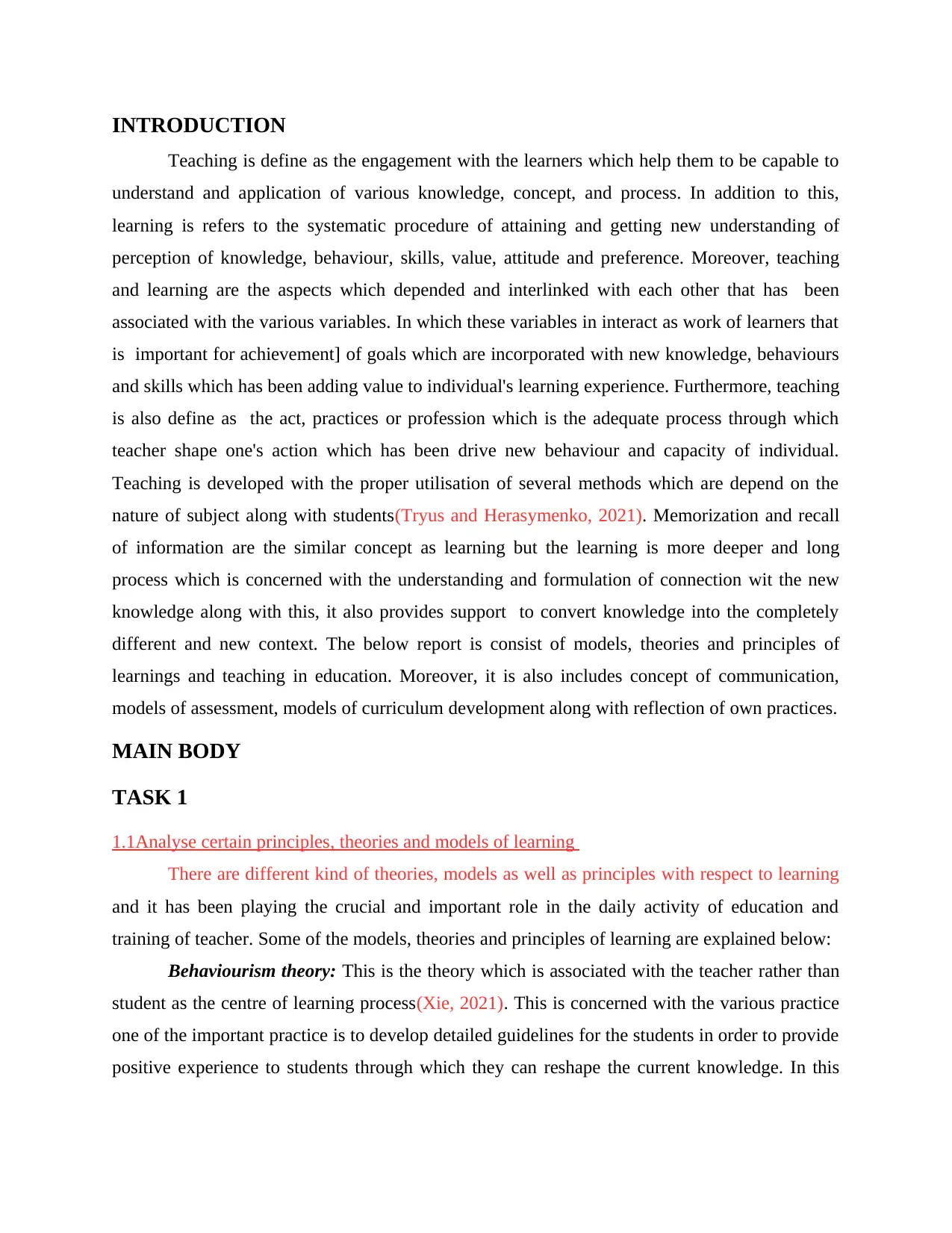
INTRODUCTION
Teaching is define as the engagement with the learners which help them to be capable to
understand and application of various knowledge, concept, and process. In addition to this,
learning is refers to the systematic procedure of attaining and getting new understanding of
perception of knowledge, behaviour, skills, value, attitude and preference. Moreover, teaching
and learning are the aspects which depended and interlinked with each other that has been
associated with the various variables. In which these variables in interact as work of learners that
is important for achievement] of goals which are incorporated with new knowledge, behaviours
and skills which has been adding value to individual's learning experience. Furthermore, teaching
is also define as the act, practices or profession which is the adequate process through which
teacher shape one's action which has been drive new behaviour and capacity of individual.
Teaching is developed with the proper utilisation of several methods which are depend on the
nature of subject along with students(Tryus and Herasymenko, 2021). Memorization and recall
of information are the similar concept as learning but the learning is more deeper and long
process which is concerned with the understanding and formulation of connection wit the new
knowledge along with this, it also provides support to convert knowledge into the completely
different and new context. The below report is consist of models, theories and principles of
learnings and teaching in education. Moreover, it is also includes concept of communication,
models of assessment, models of curriculum development along with reflection of own practices.
MAIN BODY
TASK 1
1.1Analyse certain principles, theories and models of learning
There are different kind of theories, models as well as principles with respect to learning
and it has been playing the crucial and important role in the daily activity of education and
training of teacher. Some of the models, theories and principles of learning are explained below:
Behaviourism theory: This is the theory which is associated with the teacher rather than
student as the centre of learning process(Xie, 2021). This is concerned with the various practice
one of the important practice is to develop detailed guidelines for the students in order to provide
positive experience to students through which they can reshape the current knowledge. In this
Teaching is define as the engagement with the learners which help them to be capable to
understand and application of various knowledge, concept, and process. In addition to this,
learning is refers to the systematic procedure of attaining and getting new understanding of
perception of knowledge, behaviour, skills, value, attitude and preference. Moreover, teaching
and learning are the aspects which depended and interlinked with each other that has been
associated with the various variables. In which these variables in interact as work of learners that
is important for achievement] of goals which are incorporated with new knowledge, behaviours
and skills which has been adding value to individual's learning experience. Furthermore, teaching
is also define as the act, practices or profession which is the adequate process through which
teacher shape one's action which has been drive new behaviour and capacity of individual.
Teaching is developed with the proper utilisation of several methods which are depend on the
nature of subject along with students(Tryus and Herasymenko, 2021). Memorization and recall
of information are the similar concept as learning but the learning is more deeper and long
process which is concerned with the understanding and formulation of connection wit the new
knowledge along with this, it also provides support to convert knowledge into the completely
different and new context. The below report is consist of models, theories and principles of
learnings and teaching in education. Moreover, it is also includes concept of communication,
models of assessment, models of curriculum development along with reflection of own practices.
MAIN BODY
TASK 1
1.1Analyse certain principles, theories and models of learning
There are different kind of theories, models as well as principles with respect to learning
and it has been playing the crucial and important role in the daily activity of education and
training of teacher. Some of the models, theories and principles of learning are explained below:
Behaviourism theory: This is the theory which is associated with the teacher rather than
student as the centre of learning process(Xie, 2021). This is concerned with the various practice
one of the important practice is to develop detailed guidelines for the students in order to provide
positive experience to students through which they can reshape the current knowledge. In this
⊘ This is a preview!⊘
Do you want full access?
Subscribe today to unlock all pages.

Trusted by 1+ million students worldwide
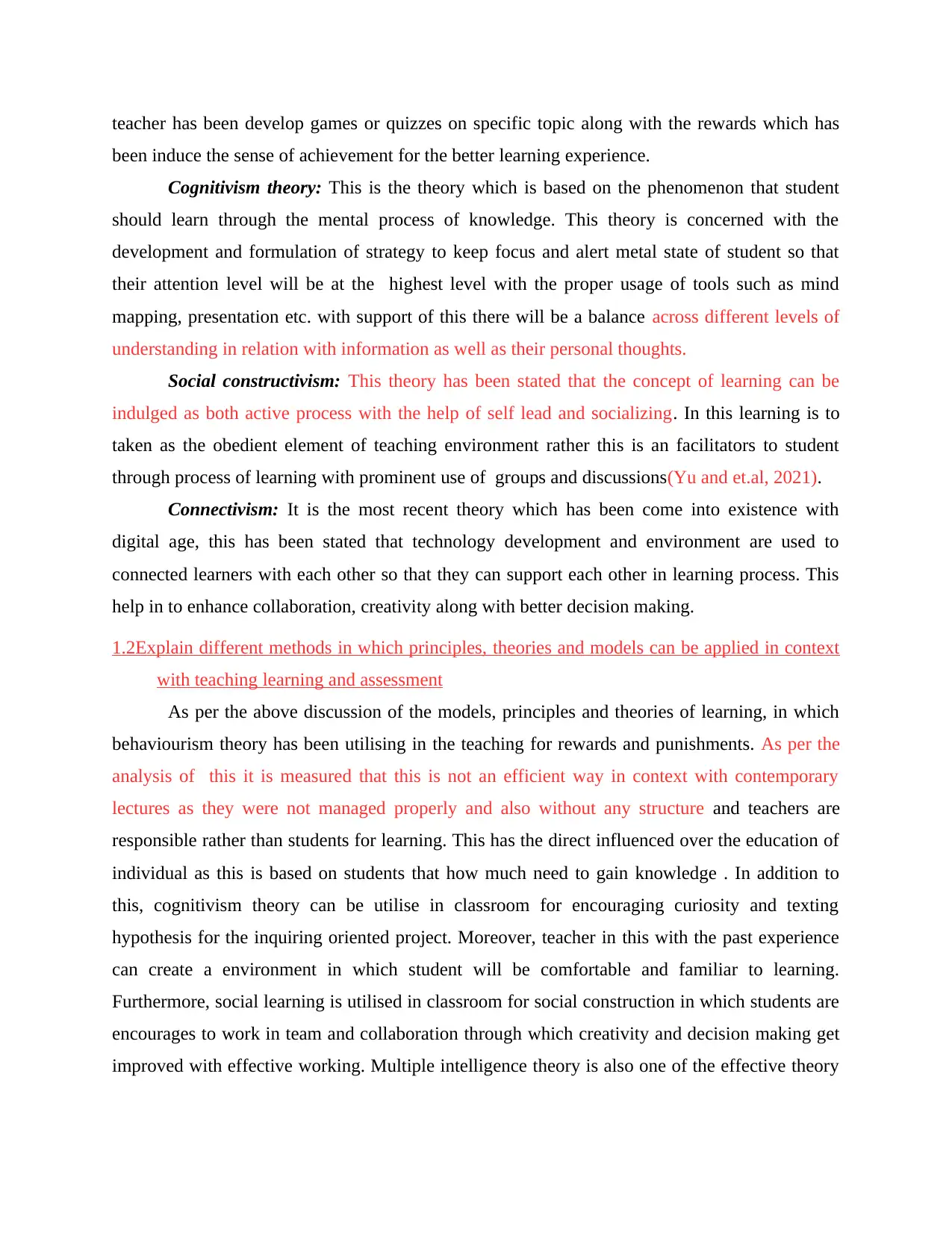
teacher has been develop games or quizzes on specific topic along with the rewards which has
been induce the sense of achievement for the better learning experience.
Cognitivism theory: This is the theory which is based on the phenomenon that student
should learn through the mental process of knowledge. This theory is concerned with the
development and formulation of strategy to keep focus and alert metal state of student so that
their attention level will be at the highest level with the proper usage of tools such as mind
mapping, presentation etc. with support of this there will be a balance across different levels of
understanding in relation with information as well as their personal thoughts.
Social constructivism: This theory has been stated that the concept of learning can be
indulged as both active process with the help of self lead and socializing. In this learning is to
taken as the obedient element of teaching environment rather this is an facilitators to student
through process of learning with prominent use of groups and discussions(Yu and et.al, 2021).
Connectivism: It is the most recent theory which has been come into existence with
digital age, this has been stated that technology development and environment are used to
connected learners with each other so that they can support each other in learning process. This
help in to enhance collaboration, creativity along with better decision making.
1.2Explain different methods in which principles, theories and models can be applied in context
with teaching learning and assessment
As per the above discussion of the models, principles and theories of learning, in which
behaviourism theory has been utilising in the teaching for rewards and punishments. As per the
analysis of this it is measured that this is not an efficient way in context with contemporary
lectures as they were not managed properly and also without any structure and teachers are
responsible rather than students for learning. This has the direct influenced over the education of
individual as this is based on students that how much need to gain knowledge . In addition to
this, cognitivism theory can be utilise in classroom for encouraging curiosity and texting
hypothesis for the inquiring oriented project. Moreover, teacher in this with the past experience
can create a environment in which student will be comfortable and familiar to learning.
Furthermore, social learning is utilised in classroom for social construction in which students are
encourages to work in team and collaboration through which creativity and decision making get
improved with effective working. Multiple intelligence theory is also one of the effective theory
been induce the sense of achievement for the better learning experience.
Cognitivism theory: This is the theory which is based on the phenomenon that student
should learn through the mental process of knowledge. This theory is concerned with the
development and formulation of strategy to keep focus and alert metal state of student so that
their attention level will be at the highest level with the proper usage of tools such as mind
mapping, presentation etc. with support of this there will be a balance across different levels of
understanding in relation with information as well as their personal thoughts.
Social constructivism: This theory has been stated that the concept of learning can be
indulged as both active process with the help of self lead and socializing. In this learning is to
taken as the obedient element of teaching environment rather this is an facilitators to student
through process of learning with prominent use of groups and discussions(Yu and et.al, 2021).
Connectivism: It is the most recent theory which has been come into existence with
digital age, this has been stated that technology development and environment are used to
connected learners with each other so that they can support each other in learning process. This
help in to enhance collaboration, creativity along with better decision making.
1.2Explain different methods in which principles, theories and models can be applied in context
with teaching learning and assessment
As per the above discussion of the models, principles and theories of learning, in which
behaviourism theory has been utilising in the teaching for rewards and punishments. As per the
analysis of this it is measured that this is not an efficient way in context with contemporary
lectures as they were not managed properly and also without any structure and teachers are
responsible rather than students for learning. This has the direct influenced over the education of
individual as this is based on students that how much need to gain knowledge . In addition to
this, cognitivism theory can be utilise in classroom for encouraging curiosity and texting
hypothesis for the inquiring oriented project. Moreover, teacher in this with the past experience
can create a environment in which student will be comfortable and familiar to learning.
Furthermore, social learning is utilised in classroom for social construction in which students are
encourages to work in team and collaboration through which creativity and decision making get
improved with effective working. Multiple intelligence theory is also one of the effective theory
Paraphrase This Document
Need a fresh take? Get an instant paraphrase of this document with our AI Paraphraser
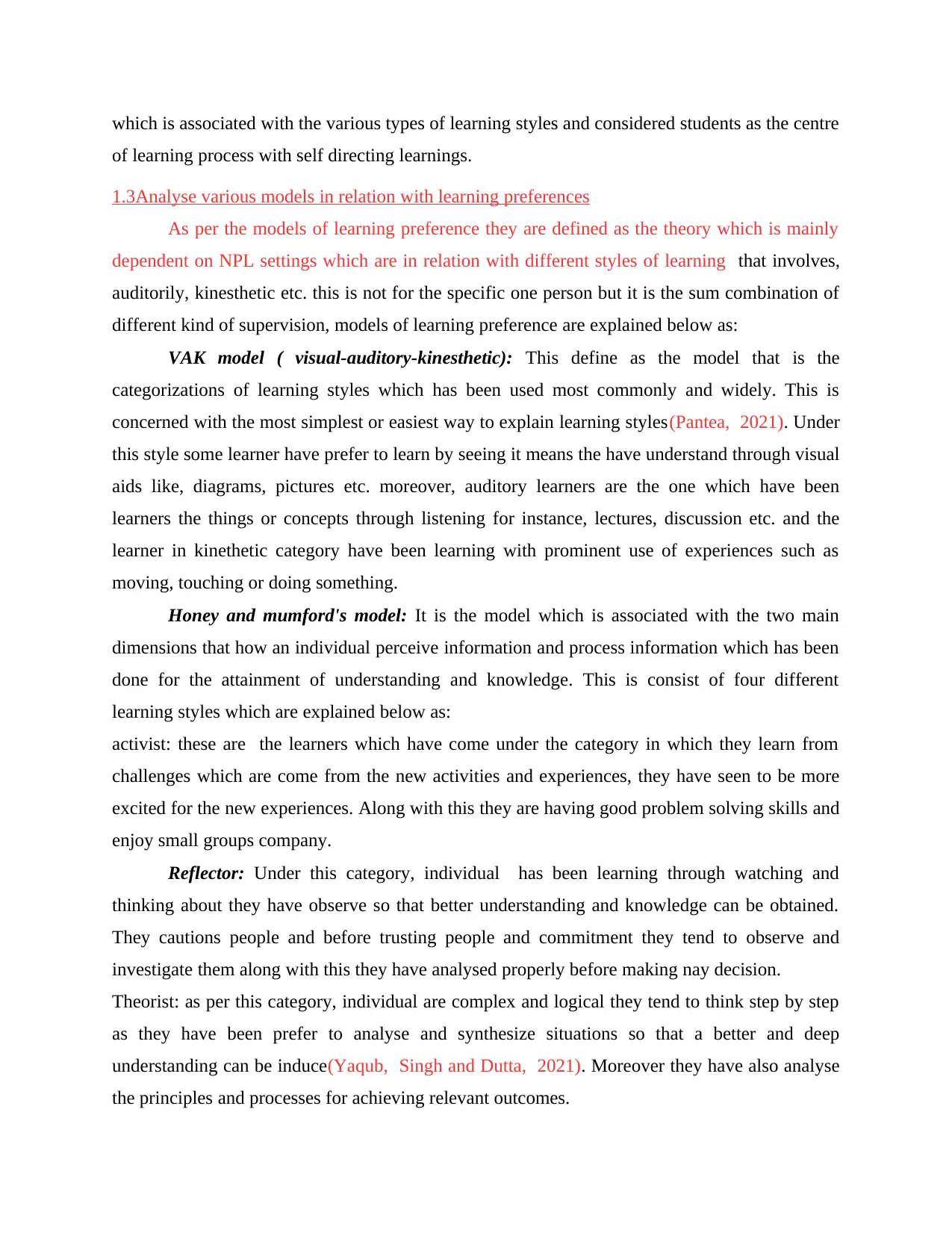
which is associated with the various types of learning styles and considered students as the centre
of learning process with self directing learnings.
1.3Analyse various models in relation with learning preferences
As per the models of learning preference they are defined as the theory which is mainly
dependent on NPL settings which are in relation with different styles of learning that involves,
auditorily, kinesthetic etc. this is not for the specific one person but it is the sum combination of
different kind of supervision, models of learning preference are explained below as:
VAK model ( visual-auditory-kinesthetic): This define as the model that is the
categorizations of learning styles which has been used most commonly and widely. This is
concerned with the most simplest or easiest way to explain learning styles(Pantea, 2021). Under
this style some learner have prefer to learn by seeing it means the have understand through visual
aids like, diagrams, pictures etc. moreover, auditory learners are the one which have been
learners the things or concepts through listening for instance, lectures, discussion etc. and the
learner in kinethetic category have been learning with prominent use of experiences such as
moving, touching or doing something.
Honey and mumford's model: It is the model which is associated with the two main
dimensions that how an individual perceive information and process information which has been
done for the attainment of understanding and knowledge. This is consist of four different
learning styles which are explained below as:
activist: these are the learners which have come under the category in which they learn from
challenges which are come from the new activities and experiences, they have seen to be more
excited for the new experiences. Along with this they are having good problem solving skills and
enjoy small groups company.
Reflector: Under this category, individual has been learning through watching and
thinking about they have observe so that better understanding and knowledge can be obtained.
They cautions people and before trusting people and commitment they tend to observe and
investigate them along with this they have analysed properly before making nay decision.
Theorist: as per this category, individual are complex and logical they tend to think step by step
as they have been prefer to analyse and synthesize situations so that a better and deep
understanding can be induce(Yaqub, Singh and Dutta, 2021). Moreover they have also analyse
the principles and processes for achieving relevant outcomes.
of learning process with self directing learnings.
1.3Analyse various models in relation with learning preferences
As per the models of learning preference they are defined as the theory which is mainly
dependent on NPL settings which are in relation with different styles of learning that involves,
auditorily, kinesthetic etc. this is not for the specific one person but it is the sum combination of
different kind of supervision, models of learning preference are explained below as:
VAK model ( visual-auditory-kinesthetic): This define as the model that is the
categorizations of learning styles which has been used most commonly and widely. This is
concerned with the most simplest or easiest way to explain learning styles(Pantea, 2021). Under
this style some learner have prefer to learn by seeing it means the have understand through visual
aids like, diagrams, pictures etc. moreover, auditory learners are the one which have been
learners the things or concepts through listening for instance, lectures, discussion etc. and the
learner in kinethetic category have been learning with prominent use of experiences such as
moving, touching or doing something.
Honey and mumford's model: It is the model which is associated with the two main
dimensions that how an individual perceive information and process information which has been
done for the attainment of understanding and knowledge. This is consist of four different
learning styles which are explained below as:
activist: these are the learners which have come under the category in which they learn from
challenges which are come from the new activities and experiences, they have seen to be more
excited for the new experiences. Along with this they are having good problem solving skills and
enjoy small groups company.
Reflector: Under this category, individual has been learning through watching and
thinking about they have observe so that better understanding and knowledge can be obtained.
They cautions people and before trusting people and commitment they tend to observe and
investigate them along with this they have analysed properly before making nay decision.
Theorist: as per this category, individual are complex and logical they tend to think step by step
as they have been prefer to analyse and synthesize situations so that a better and deep
understanding can be induce(Yaqub, Singh and Dutta, 2021). Moreover they have also analyse
the principles and processes for achieving relevant outcomes.
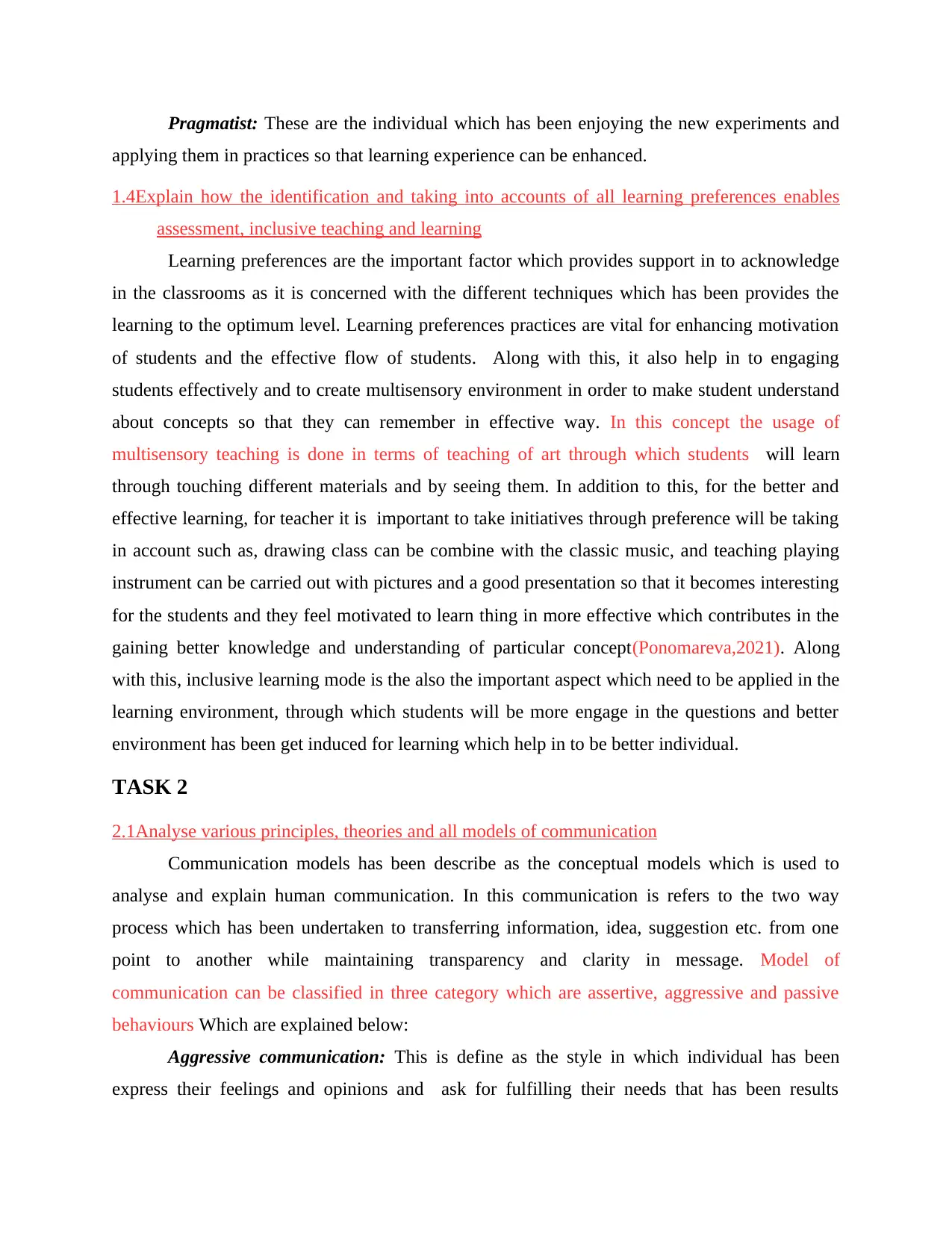
Pragmatist: These are the individual which has been enjoying the new experiments and
applying them in practices so that learning experience can be enhanced.
1.4Explain how the identification and taking into accounts of all learning preferences enables
assessment, inclusive teaching and learning
Learning preferences are the important factor which provides support in to acknowledge
in the classrooms as it is concerned with the different techniques which has been provides the
learning to the optimum level. Learning preferences practices are vital for enhancing motivation
of students and the effective flow of students. Along with this, it also help in to engaging
students effectively and to create multisensory environment in order to make student understand
about concepts so that they can remember in effective way. In this concept the usage of
multisensory teaching is done in terms of teaching of art through which students will learn
through touching different materials and by seeing them. In addition to this, for the better and
effective learning, for teacher it is important to take initiatives through preference will be taking
in account such as, drawing class can be combine with the classic music, and teaching playing
instrument can be carried out with pictures and a good presentation so that it becomes interesting
for the students and they feel motivated to learn thing in more effective which contributes in the
gaining better knowledge and understanding of particular concept(Ponomareva,2021). Along
with this, inclusive learning mode is the also the important aspect which need to be applied in the
learning environment, through which students will be more engage in the questions and better
environment has been get induced for learning which help in to be better individual.
TASK 2
2.1Analyse various principles, theories and all models of communication
Communication models has been describe as the conceptual models which is used to
analyse and explain human communication. In this communication is refers to the two way
process which has been undertaken to transferring information, idea, suggestion etc. from one
point to another while maintaining transparency and clarity in message. Model of
communication can be classified in three category which are assertive, aggressive and passive
behaviours Which are explained below:
Aggressive communication: This is define as the style in which individual has been
express their feelings and opinions and ask for fulfilling their needs that has been results
applying them in practices so that learning experience can be enhanced.
1.4Explain how the identification and taking into accounts of all learning preferences enables
assessment, inclusive teaching and learning
Learning preferences are the important factor which provides support in to acknowledge
in the classrooms as it is concerned with the different techniques which has been provides the
learning to the optimum level. Learning preferences practices are vital for enhancing motivation
of students and the effective flow of students. Along with this, it also help in to engaging
students effectively and to create multisensory environment in order to make student understand
about concepts so that they can remember in effective way. In this concept the usage of
multisensory teaching is done in terms of teaching of art through which students will learn
through touching different materials and by seeing them. In addition to this, for the better and
effective learning, for teacher it is important to take initiatives through preference will be taking
in account such as, drawing class can be combine with the classic music, and teaching playing
instrument can be carried out with pictures and a good presentation so that it becomes interesting
for the students and they feel motivated to learn thing in more effective which contributes in the
gaining better knowledge and understanding of particular concept(Ponomareva,2021). Along
with this, inclusive learning mode is the also the important aspect which need to be applied in the
learning environment, through which students will be more engage in the questions and better
environment has been get induced for learning which help in to be better individual.
TASK 2
2.1Analyse various principles, theories and all models of communication
Communication models has been describe as the conceptual models which is used to
analyse and explain human communication. In this communication is refers to the two way
process which has been undertaken to transferring information, idea, suggestion etc. from one
point to another while maintaining transparency and clarity in message. Model of
communication can be classified in three category which are assertive, aggressive and passive
behaviours Which are explained below:
Aggressive communication: This is define as the style in which individual has been
express their feelings and opinions and ask for fulfilling their needs that has been results
⊘ This is a preview!⊘
Do you want full access?
Subscribe today to unlock all pages.

Trusted by 1+ million students worldwide
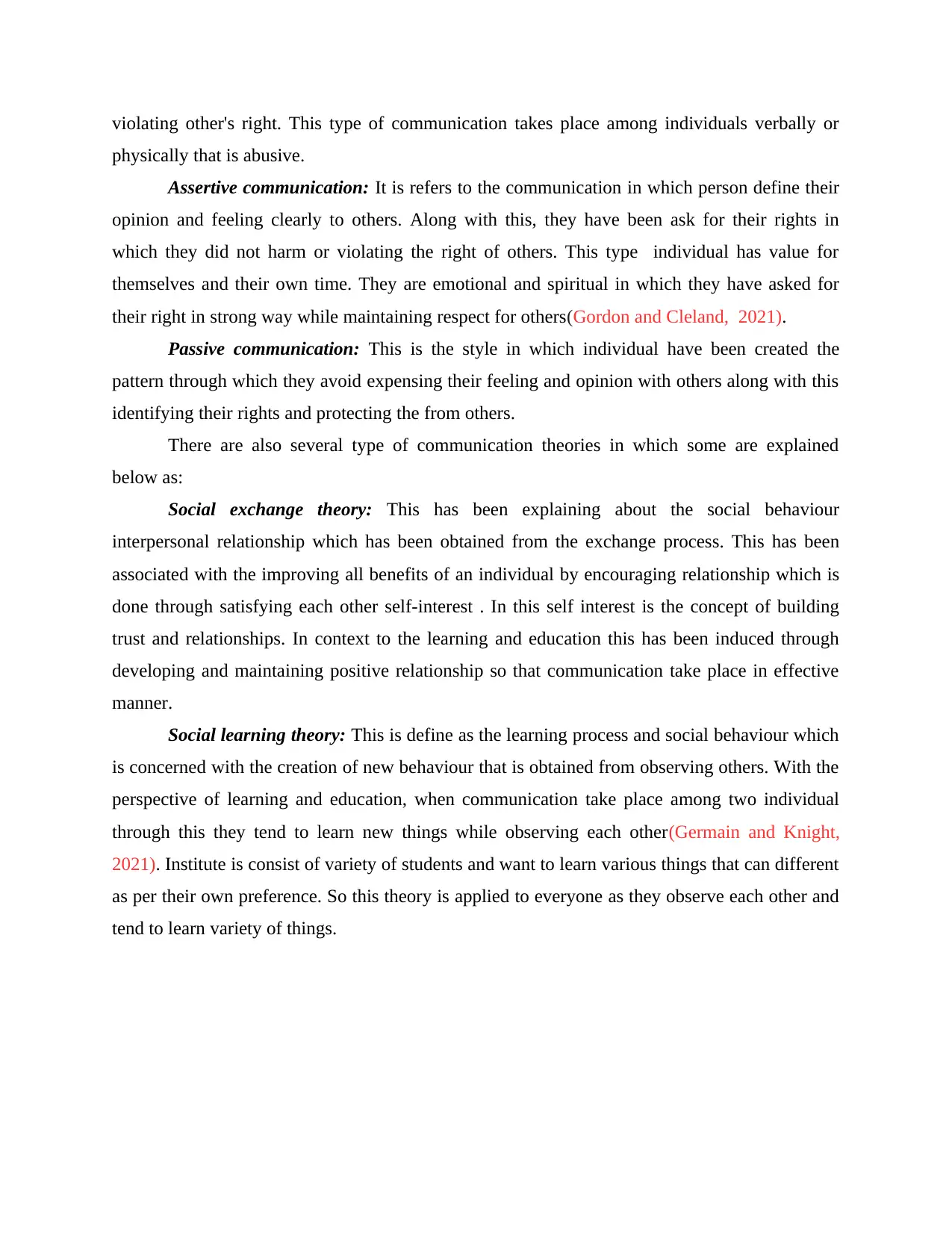
violating other's right. This type of communication takes place among individuals verbally or
physically that is abusive.
Assertive communication: It is refers to the communication in which person define their
opinion and feeling clearly to others. Along with this, they have been ask for their rights in
which they did not harm or violating the right of others. This type individual has value for
themselves and their own time. They are emotional and spiritual in which they have asked for
their right in strong way while maintaining respect for others(Gordon and Cleland, 2021).
Passive communication: This is the style in which individual have been created the
pattern through which they avoid expensing their feeling and opinion with others along with this
identifying their rights and protecting the from others.
There are also several type of communication theories in which some are explained
below as:
Social exchange theory: This has been explaining about the social behaviour
interpersonal relationship which has been obtained from the exchange process. This has been
associated with the improving all benefits of an individual by encouraging relationship which is
done through satisfying each other self-interest . In this self interest is the concept of building
trust and relationships. In context to the learning and education this has been induced through
developing and maintaining positive relationship so that communication take place in effective
manner.
Social learning theory: This is define as the learning process and social behaviour which
is concerned with the creation of new behaviour that is obtained from observing others. With the
perspective of learning and education, when communication take place among two individual
through this they tend to learn new things while observing each other(Germain and Knight,
2021). Institute is consist of variety of students and want to learn various things that can different
as per their own preference. So this theory is applied to everyone as they observe each other and
tend to learn variety of things.
physically that is abusive.
Assertive communication: It is refers to the communication in which person define their
opinion and feeling clearly to others. Along with this, they have been ask for their rights in
which they did not harm or violating the right of others. This type individual has value for
themselves and their own time. They are emotional and spiritual in which they have asked for
their right in strong way while maintaining respect for others(Gordon and Cleland, 2021).
Passive communication: This is the style in which individual have been created the
pattern through which they avoid expensing their feeling and opinion with others along with this
identifying their rights and protecting the from others.
There are also several type of communication theories in which some are explained
below as:
Social exchange theory: This has been explaining about the social behaviour
interpersonal relationship which has been obtained from the exchange process. This has been
associated with the improving all benefits of an individual by encouraging relationship which is
done through satisfying each other self-interest . In this self interest is the concept of building
trust and relationships. In context to the learning and education this has been induced through
developing and maintaining positive relationship so that communication take place in effective
manner.
Social learning theory: This is define as the learning process and social behaviour which
is concerned with the creation of new behaviour that is obtained from observing others. With the
perspective of learning and education, when communication take place among two individual
through this they tend to learn new things while observing each other(Germain and Knight,
2021). Institute is consist of variety of students and want to learn various things that can different
as per their own preference. So this theory is applied to everyone as they observe each other and
tend to learn variety of things.
Paraphrase This Document
Need a fresh take? Get an instant paraphrase of this document with our AI Paraphraser
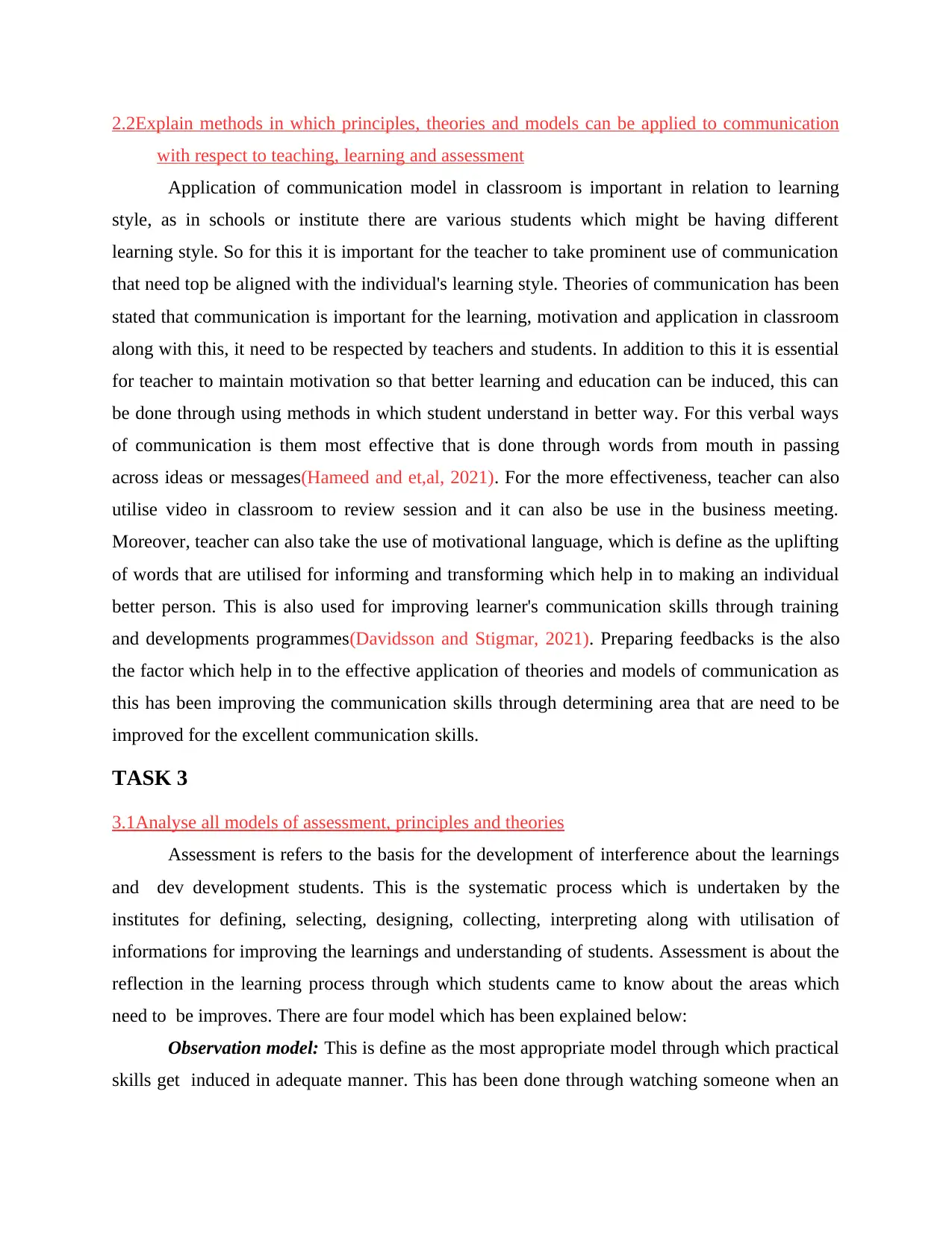
2.2Explain methods in which principles, theories and models can be applied to communication
with respect to teaching, learning and assessment
Application of communication model in classroom is important in relation to learning
style, as in schools or institute there are various students which might be having different
learning style. So for this it is important for the teacher to take prominent use of communication
that need top be aligned with the individual's learning style. Theories of communication has been
stated that communication is important for the learning, motivation and application in classroom
along with this, it need to be respected by teachers and students. In addition to this it is essential
for teacher to maintain motivation so that better learning and education can be induced, this can
be done through using methods in which student understand in better way. For this verbal ways
of communication is them most effective that is done through words from mouth in passing
across ideas or messages(Hameed and et,al, 2021). For the more effectiveness, teacher can also
utilise video in classroom to review session and it can also be use in the business meeting.
Moreover, teacher can also take the use of motivational language, which is define as the uplifting
of words that are utilised for informing and transforming which help in to making an individual
better person. This is also used for improving learner's communication skills through training
and developments programmes(Davidsson and Stigmar, 2021). Preparing feedbacks is the also
the factor which help in to the effective application of theories and models of communication as
this has been improving the communication skills through determining area that are need to be
improved for the excellent communication skills.
TASK 3
3.1Analyse all models of assessment, principles and theories
Assessment is refers to the basis for the development of interference about the learnings
and dev development students. This is the systematic process which is undertaken by the
institutes for defining, selecting, designing, collecting, interpreting along with utilisation of
informations for improving the learnings and understanding of students. Assessment is about the
reflection in the learning process through which students came to know about the areas which
need to be improves. There are four model which has been explained below:
Observation model: This is define as the most appropriate model through which practical
skills get induced in adequate manner. This has been done through watching someone when an
with respect to teaching, learning and assessment
Application of communication model in classroom is important in relation to learning
style, as in schools or institute there are various students which might be having different
learning style. So for this it is important for the teacher to take prominent use of communication
that need top be aligned with the individual's learning style. Theories of communication has been
stated that communication is important for the learning, motivation and application in classroom
along with this, it need to be respected by teachers and students. In addition to this it is essential
for teacher to maintain motivation so that better learning and education can be induced, this can
be done through using methods in which student understand in better way. For this verbal ways
of communication is them most effective that is done through words from mouth in passing
across ideas or messages(Hameed and et,al, 2021). For the more effectiveness, teacher can also
utilise video in classroom to review session and it can also be use in the business meeting.
Moreover, teacher can also take the use of motivational language, which is define as the uplifting
of words that are utilised for informing and transforming which help in to making an individual
better person. This is also used for improving learner's communication skills through training
and developments programmes(Davidsson and Stigmar, 2021). Preparing feedbacks is the also
the factor which help in to the effective application of theories and models of communication as
this has been improving the communication skills through determining area that are need to be
improved for the excellent communication skills.
TASK 3
3.1Analyse all models of assessment, principles and theories
Assessment is refers to the basis for the development of interference about the learnings
and dev development students. This is the systematic process which is undertaken by the
institutes for defining, selecting, designing, collecting, interpreting along with utilisation of
informations for improving the learnings and understanding of students. Assessment is about the
reflection in the learning process through which students came to know about the areas which
need to be improves. There are four model which has been explained below:
Observation model: This is define as the most appropriate model through which practical
skills get induced in adequate manner. This has been done through watching someone when an
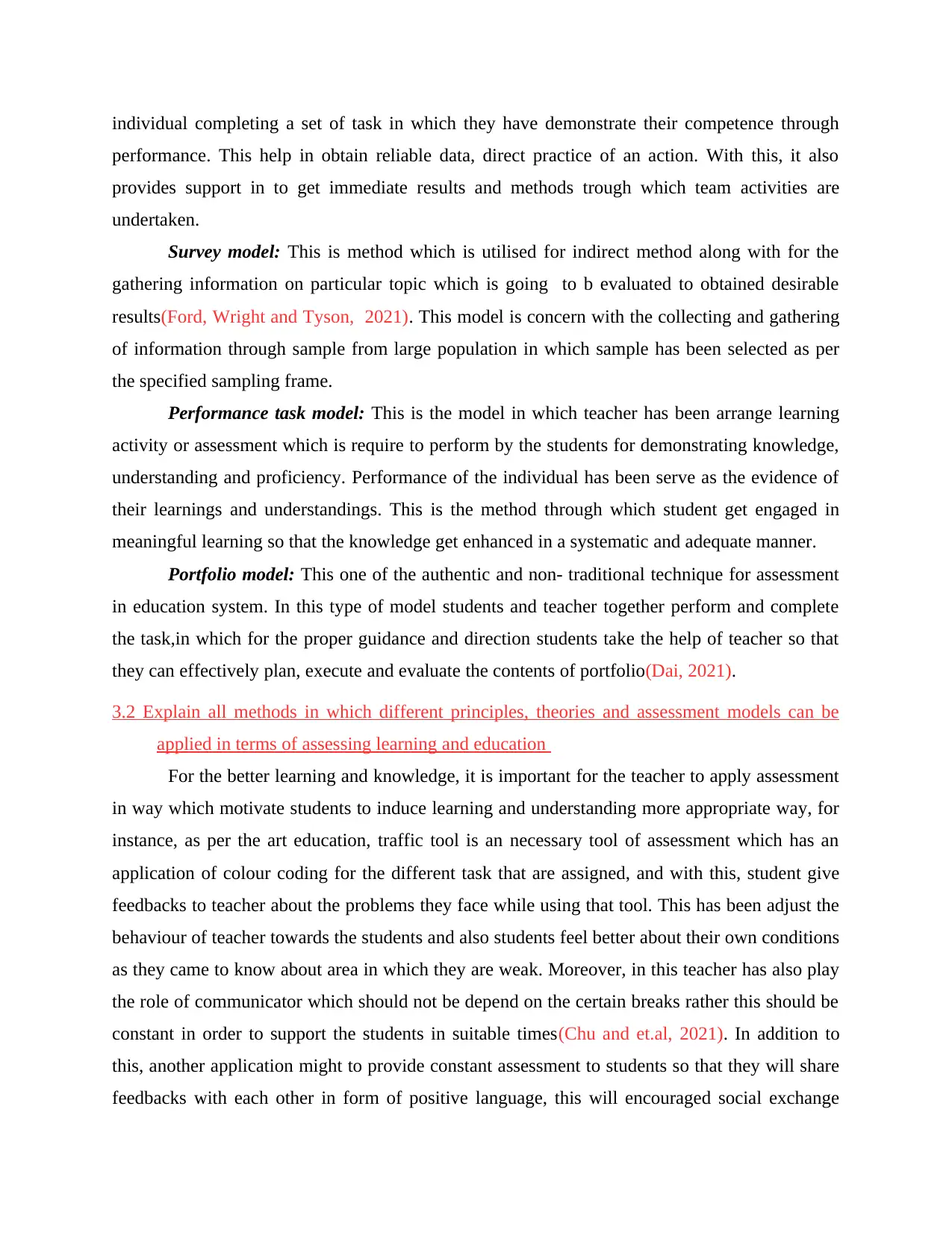
individual completing a set of task in which they have demonstrate their competence through
performance. This help in obtain reliable data, direct practice of an action. With this, it also
provides support in to get immediate results and methods trough which team activities are
undertaken.
Survey model: This is method which is utilised for indirect method along with for the
gathering information on particular topic which is going to b evaluated to obtained desirable
results(Ford, Wright and Tyson, 2021). This model is concern with the collecting and gathering
of information through sample from large population in which sample has been selected as per
the specified sampling frame.
Performance task model: This is the model in which teacher has been arrange learning
activity or assessment which is require to perform by the students for demonstrating knowledge,
understanding and proficiency. Performance of the individual has been serve as the evidence of
their learnings and understandings. This is the method through which student get engaged in
meaningful learning so that the knowledge get enhanced in a systematic and adequate manner.
Portfolio model: This one of the authentic and non- traditional technique for assessment
in education system. In this type of model students and teacher together perform and complete
the task,in which for the proper guidance and direction students take the help of teacher so that
they can effectively plan, execute and evaluate the contents of portfolio(Dai, 2021).
3.2 Explain all methods in which different principles, theories and assessment models can be
applied in terms of assessing learning and education
For the better learning and knowledge, it is important for the teacher to apply assessment
in way which motivate students to induce learning and understanding more appropriate way, for
instance, as per the art education, traffic tool is an necessary tool of assessment which has an
application of colour coding for the different task that are assigned, and with this, student give
feedbacks to teacher about the problems they face while using that tool. This has been adjust the
behaviour of teacher towards the students and also students feel better about their own conditions
as they came to know about area in which they are weak. Moreover, in this teacher has also play
the role of communicator which should not be depend on the certain breaks rather this should be
constant in order to support the students in suitable times(Chu and et.al, 2021). In addition to
this, another application might to provide constant assessment to students so that they will share
feedbacks with each other in form of positive language, this will encouraged social exchange
performance. This help in obtain reliable data, direct practice of an action. With this, it also
provides support in to get immediate results and methods trough which team activities are
undertaken.
Survey model: This is method which is utilised for indirect method along with for the
gathering information on particular topic which is going to b evaluated to obtained desirable
results(Ford, Wright and Tyson, 2021). This model is concern with the collecting and gathering
of information through sample from large population in which sample has been selected as per
the specified sampling frame.
Performance task model: This is the model in which teacher has been arrange learning
activity or assessment which is require to perform by the students for demonstrating knowledge,
understanding and proficiency. Performance of the individual has been serve as the evidence of
their learnings and understandings. This is the method through which student get engaged in
meaningful learning so that the knowledge get enhanced in a systematic and adequate manner.
Portfolio model: This one of the authentic and non- traditional technique for assessment
in education system. In this type of model students and teacher together perform and complete
the task,in which for the proper guidance and direction students take the help of teacher so that
they can effectively plan, execute and evaluate the contents of portfolio(Dai, 2021).
3.2 Explain all methods in which different principles, theories and assessment models can be
applied in terms of assessing learning and education
For the better learning and knowledge, it is important for the teacher to apply assessment
in way which motivate students to induce learning and understanding more appropriate way, for
instance, as per the art education, traffic tool is an necessary tool of assessment which has an
application of colour coding for the different task that are assigned, and with this, student give
feedbacks to teacher about the problems they face while using that tool. This has been adjust the
behaviour of teacher towards the students and also students feel better about their own conditions
as they came to know about area in which they are weak. Moreover, in this teacher has also play
the role of communicator which should not be depend on the certain breaks rather this should be
constant in order to support the students in suitable times(Chu and et.al, 2021). In addition to
this, another application might to provide constant assessment to students so that they will share
feedbacks with each other in form of positive language, this will encouraged social exchange
⊘ This is a preview!⊘
Do you want full access?
Subscribe today to unlock all pages.

Trusted by 1+ million students worldwide
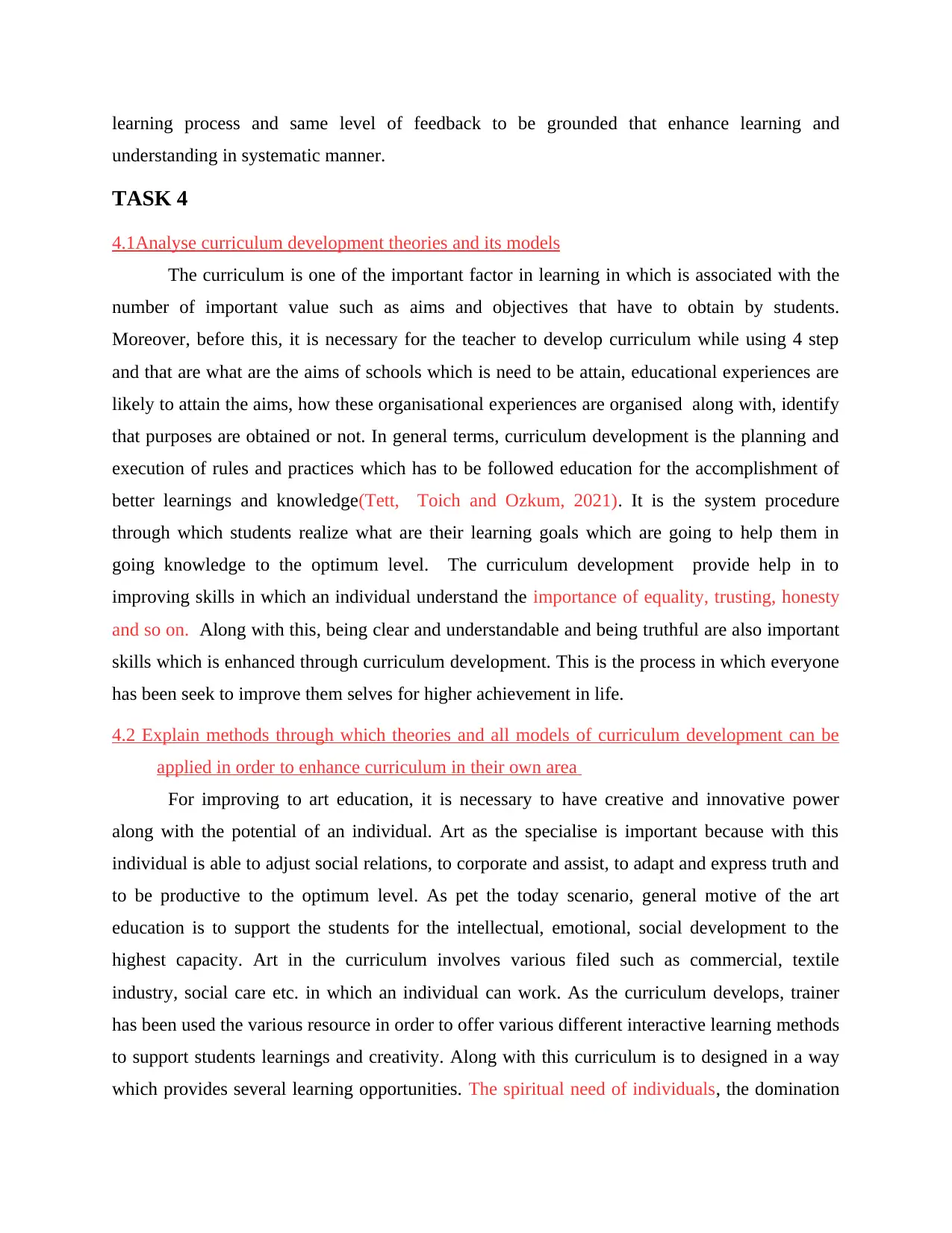
learning process and same level of feedback to be grounded that enhance learning and
understanding in systematic manner.
TASK 4
4.1Analyse curriculum development theories and its models
The curriculum is one of the important factor in learning in which is associated with the
number of important value such as aims and objectives that have to obtain by students.
Moreover, before this, it is necessary for the teacher to develop curriculum while using 4 step
and that are what are the aims of schools which is need to be attain, educational experiences are
likely to attain the aims, how these organisational experiences are organised along with, identify
that purposes are obtained or not. In general terms, curriculum development is the planning and
execution of rules and practices which has to be followed education for the accomplishment of
better learnings and knowledge(Tett, Toich and Ozkum, 2021). It is the system procedure
through which students realize what are their learning goals which are going to help them in
going knowledge to the optimum level. The curriculum development provide help in to
improving skills in which an individual understand the importance of equality, trusting, honesty
and so on. Along with this, being clear and understandable and being truthful are also important
skills which is enhanced through curriculum development. This is the process in which everyone
has been seek to improve them selves for higher achievement in life.
4.2 Explain methods through which theories and all models of curriculum development can be
applied in order to enhance curriculum in their own area
For improving to art education, it is necessary to have creative and innovative power
along with the potential of an individual. Art as the specialise is important because with this
individual is able to adjust social relations, to corporate and assist, to adapt and express truth and
to be productive to the optimum level. As pet the today scenario, general motive of the art
education is to support the students for the intellectual, emotional, social development to the
highest capacity. Art in the curriculum involves various filed such as commercial, textile
industry, social care etc. in which an individual can work. As the curriculum develops, trainer
has been used the various resource in order to offer various different interactive learning methods
to support students learnings and creativity. Along with this curriculum is to designed in a way
which provides several learning opportunities. The spiritual need of individuals, the domination
understanding in systematic manner.
TASK 4
4.1Analyse curriculum development theories and its models
The curriculum is one of the important factor in learning in which is associated with the
number of important value such as aims and objectives that have to obtain by students.
Moreover, before this, it is necessary for the teacher to develop curriculum while using 4 step
and that are what are the aims of schools which is need to be attain, educational experiences are
likely to attain the aims, how these organisational experiences are organised along with, identify
that purposes are obtained or not. In general terms, curriculum development is the planning and
execution of rules and practices which has to be followed education for the accomplishment of
better learnings and knowledge(Tett, Toich and Ozkum, 2021). It is the system procedure
through which students realize what are their learning goals which are going to help them in
going knowledge to the optimum level. The curriculum development provide help in to
improving skills in which an individual understand the importance of equality, trusting, honesty
and so on. Along with this, being clear and understandable and being truthful are also important
skills which is enhanced through curriculum development. This is the process in which everyone
has been seek to improve them selves for higher achievement in life.
4.2 Explain methods through which theories and all models of curriculum development can be
applied in order to enhance curriculum in their own area
For improving to art education, it is necessary to have creative and innovative power
along with the potential of an individual. Art as the specialise is important because with this
individual is able to adjust social relations, to corporate and assist, to adapt and express truth and
to be productive to the optimum level. As pet the today scenario, general motive of the art
education is to support the students for the intellectual, emotional, social development to the
highest capacity. Art in the curriculum involves various filed such as commercial, textile
industry, social care etc. in which an individual can work. As the curriculum develops, trainer
has been used the various resource in order to offer various different interactive learning methods
to support students learnings and creativity. Along with this curriculum is to designed in a way
which provides several learning opportunities. The spiritual need of individuals, the domination
Paraphrase This Document
Need a fresh take? Get an instant paraphrase of this document with our AI Paraphraser
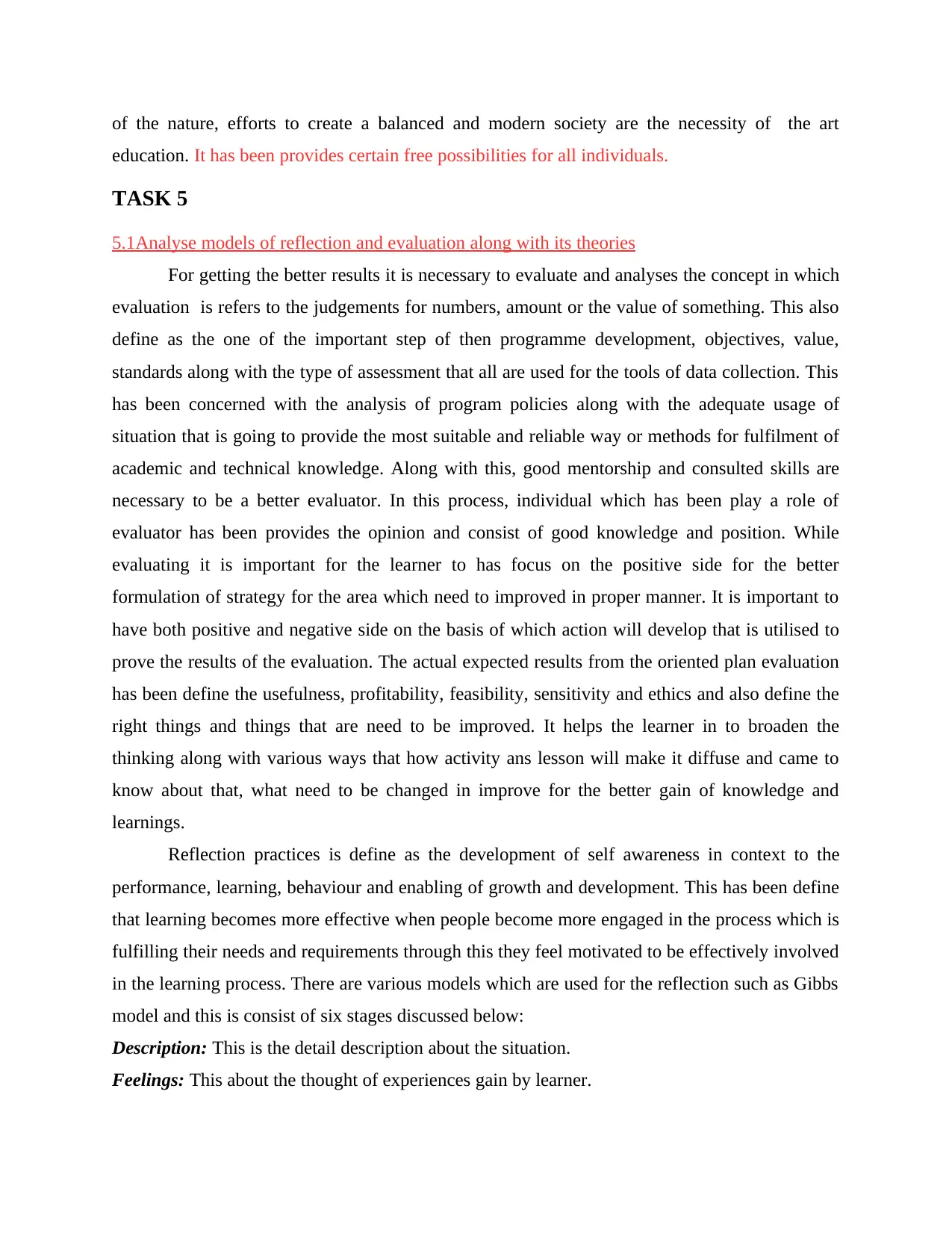
of the nature, efforts to create a balanced and modern society are the necessity of the art
education. It has been provides certain free possibilities for all individuals.
TASK 5
5.1Analyse models of reflection and evaluation along with its theories
For getting the better results it is necessary to evaluate and analyses the concept in which
evaluation is refers to the judgements for numbers, amount or the value of something. This also
define as the one of the important step of then programme development, objectives, value,
standards along with the type of assessment that all are used for the tools of data collection. This
has been concerned with the analysis of program policies along with the adequate usage of
situation that is going to provide the most suitable and reliable way or methods for fulfilment of
academic and technical knowledge. Along with this, good mentorship and consulted skills are
necessary to be a better evaluator. In this process, individual which has been play a role of
evaluator has been provides the opinion and consist of good knowledge and position. While
evaluating it is important for the learner to has focus on the positive side for the better
formulation of strategy for the area which need to improved in proper manner. It is important to
have both positive and negative side on the basis of which action will develop that is utilised to
prove the results of the evaluation. The actual expected results from the oriented plan evaluation
has been define the usefulness, profitability, feasibility, sensitivity and ethics and also define the
right things and things that are need to be improved. It helps the learner in to broaden the
thinking along with various ways that how activity ans lesson will make it diffuse and came to
know about that, what need to be changed in improve for the better gain of knowledge and
learnings.
Reflection practices is define as the development of self awareness in context to the
performance, learning, behaviour and enabling of growth and development. This has been define
that learning becomes more effective when people become more engaged in the process which is
fulfilling their needs and requirements through this they feel motivated to be effectively involved
in the learning process. There are various models which are used for the reflection such as Gibbs
model and this is consist of six stages discussed below:
Description: This is the detail description about the situation.
Feelings: This about the thought of experiences gain by learner.
education. It has been provides certain free possibilities for all individuals.
TASK 5
5.1Analyse models of reflection and evaluation along with its theories
For getting the better results it is necessary to evaluate and analyses the concept in which
evaluation is refers to the judgements for numbers, amount or the value of something. This also
define as the one of the important step of then programme development, objectives, value,
standards along with the type of assessment that all are used for the tools of data collection. This
has been concerned with the analysis of program policies along with the adequate usage of
situation that is going to provide the most suitable and reliable way or methods for fulfilment of
academic and technical knowledge. Along with this, good mentorship and consulted skills are
necessary to be a better evaluator. In this process, individual which has been play a role of
evaluator has been provides the opinion and consist of good knowledge and position. While
evaluating it is important for the learner to has focus on the positive side for the better
formulation of strategy for the area which need to improved in proper manner. It is important to
have both positive and negative side on the basis of which action will develop that is utilised to
prove the results of the evaluation. The actual expected results from the oriented plan evaluation
has been define the usefulness, profitability, feasibility, sensitivity and ethics and also define the
right things and things that are need to be improved. It helps the learner in to broaden the
thinking along with various ways that how activity ans lesson will make it diffuse and came to
know about that, what need to be changed in improve for the better gain of knowledge and
learnings.
Reflection practices is define as the development of self awareness in context to the
performance, learning, behaviour and enabling of growth and development. This has been define
that learning becomes more effective when people become more engaged in the process which is
fulfilling their needs and requirements through this they feel motivated to be effectively involved
in the learning process. There are various models which are used for the reflection such as Gibbs
model and this is consist of six stages discussed below:
Description: This is the detail description about the situation.
Feelings: This about the thought of experiences gain by learner.
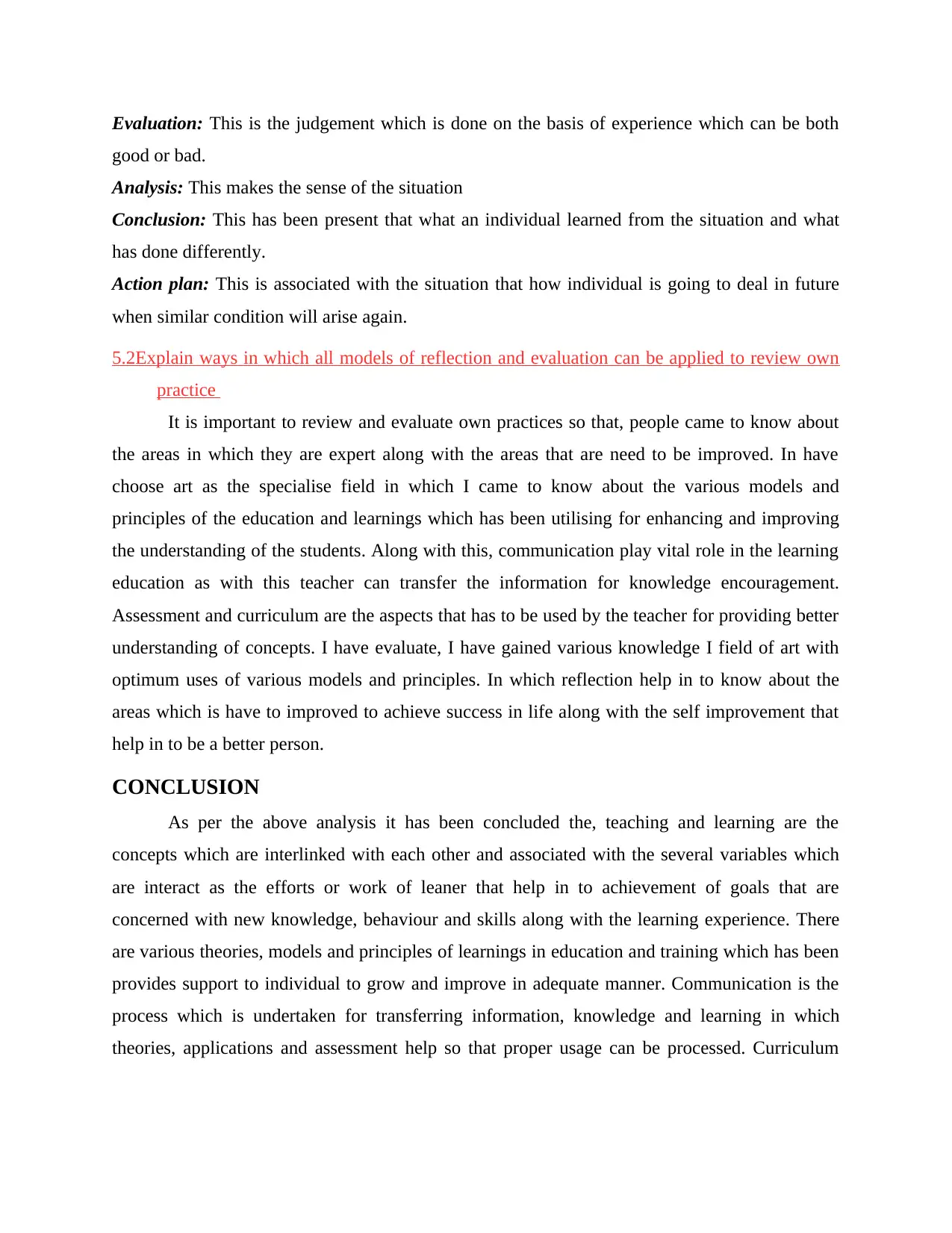
Evaluation: This is the judgement which is done on the basis of experience which can be both
good or bad.
Analysis: This makes the sense of the situation
Conclusion: This has been present that what an individual learned from the situation and what
has done differently.
Action plan: This is associated with the situation that how individual is going to deal in future
when similar condition will arise again.
5.2Explain ways in which all models of reflection and evaluation can be applied to review own
practice
It is important to review and evaluate own practices so that, people came to know about
the areas in which they are expert along with the areas that are need to be improved. In have
choose art as the specialise field in which I came to know about the various models and
principles of the education and learnings which has been utilising for enhancing and improving
the understanding of the students. Along with this, communication play vital role in the learning
education as with this teacher can transfer the information for knowledge encouragement.
Assessment and curriculum are the aspects that has to be used by the teacher for providing better
understanding of concepts. I have evaluate, I have gained various knowledge I field of art with
optimum uses of various models and principles. In which reflection help in to know about the
areas which is have to improved to achieve success in life along with the self improvement that
help in to be a better person.
CONCLUSION
As per the above analysis it has been concluded the, teaching and learning are the
concepts which are interlinked with each other and associated with the several variables which
are interact as the efforts or work of leaner that help in to achievement of goals that are
concerned with new knowledge, behaviour and skills along with the learning experience. There
are various theories, models and principles of learnings in education and training which has been
provides support to individual to grow and improve in adequate manner. Communication is the
process which is undertaken for transferring information, knowledge and learning in which
theories, applications and assessment help so that proper usage can be processed. Curriculum
good or bad.
Analysis: This makes the sense of the situation
Conclusion: This has been present that what an individual learned from the situation and what
has done differently.
Action plan: This is associated with the situation that how individual is going to deal in future
when similar condition will arise again.
5.2Explain ways in which all models of reflection and evaluation can be applied to review own
practice
It is important to review and evaluate own practices so that, people came to know about
the areas in which they are expert along with the areas that are need to be improved. In have
choose art as the specialise field in which I came to know about the various models and
principles of the education and learnings which has been utilising for enhancing and improving
the understanding of the students. Along with this, communication play vital role in the learning
education as with this teacher can transfer the information for knowledge encouragement.
Assessment and curriculum are the aspects that has to be used by the teacher for providing better
understanding of concepts. I have evaluate, I have gained various knowledge I field of art with
optimum uses of various models and principles. In which reflection help in to know about the
areas which is have to improved to achieve success in life along with the self improvement that
help in to be a better person.
CONCLUSION
As per the above analysis it has been concluded the, teaching and learning are the
concepts which are interlinked with each other and associated with the several variables which
are interact as the efforts or work of leaner that help in to achievement of goals that are
concerned with new knowledge, behaviour and skills along with the learning experience. There
are various theories, models and principles of learnings in education and training which has been
provides support to individual to grow and improve in adequate manner. Communication is the
process which is undertaken for transferring information, knowledge and learning in which
theories, applications and assessment help so that proper usage can be processed. Curriculum
⊘ This is a preview!⊘
Do you want full access?
Subscribe today to unlock all pages.

Trusted by 1+ million students worldwide
1 out of 14
Related Documents
Your All-in-One AI-Powered Toolkit for Academic Success.
+13062052269
info@desklib.com
Available 24*7 on WhatsApp / Email
![[object Object]](/_next/static/media/star-bottom.7253800d.svg)
Unlock your academic potential
Copyright © 2020–2025 A2Z Services. All Rights Reserved. Developed and managed by ZUCOL.





